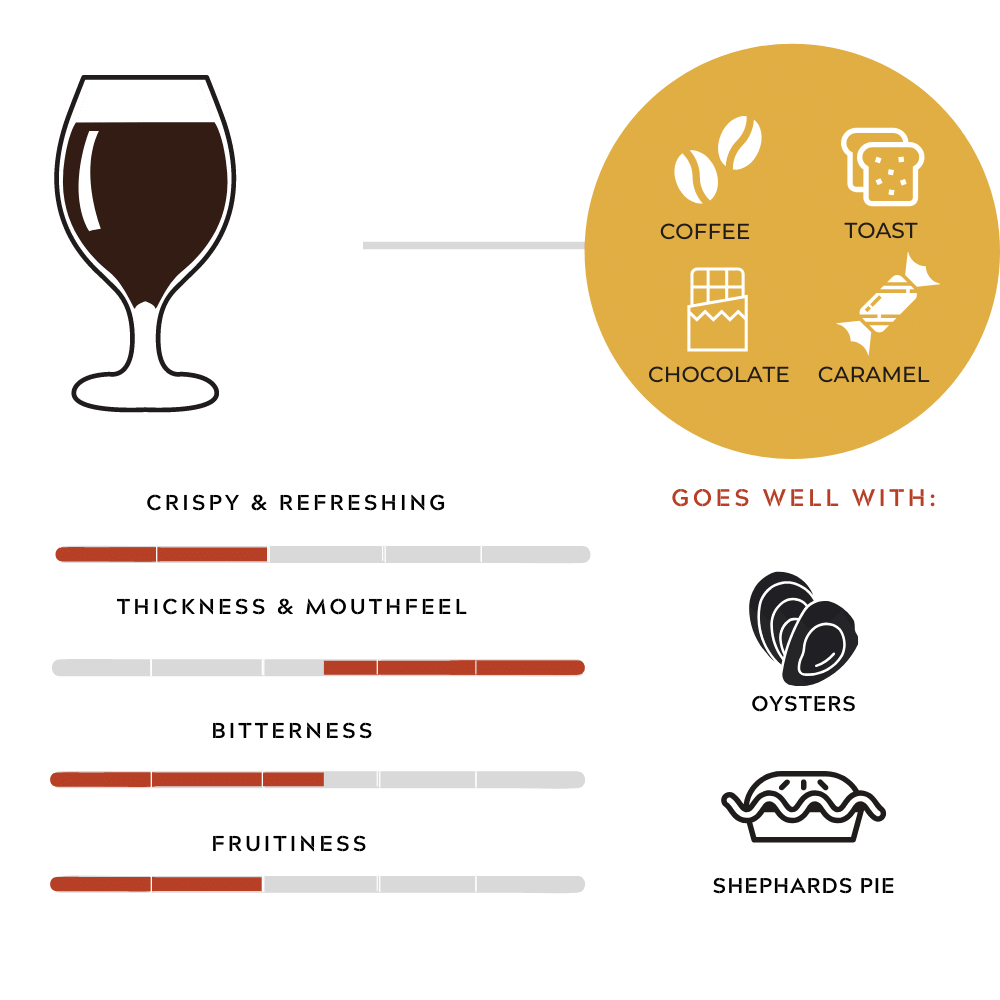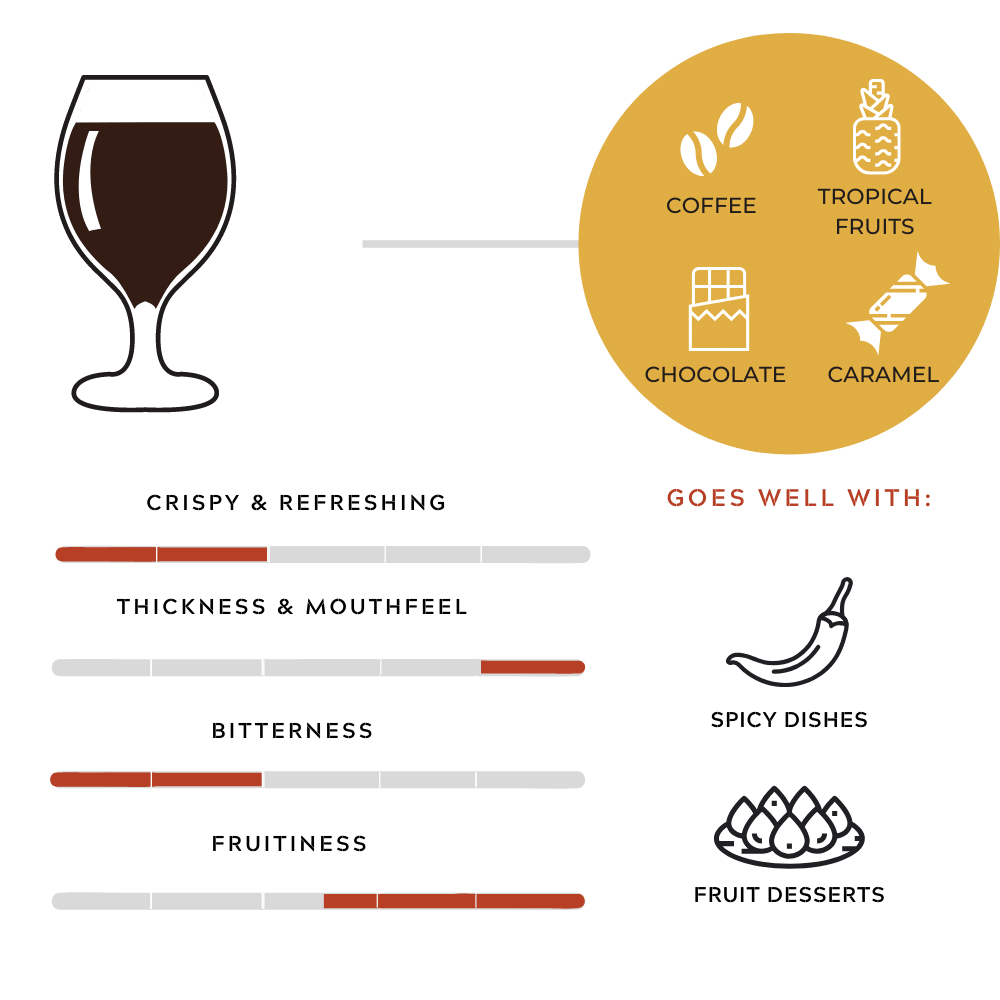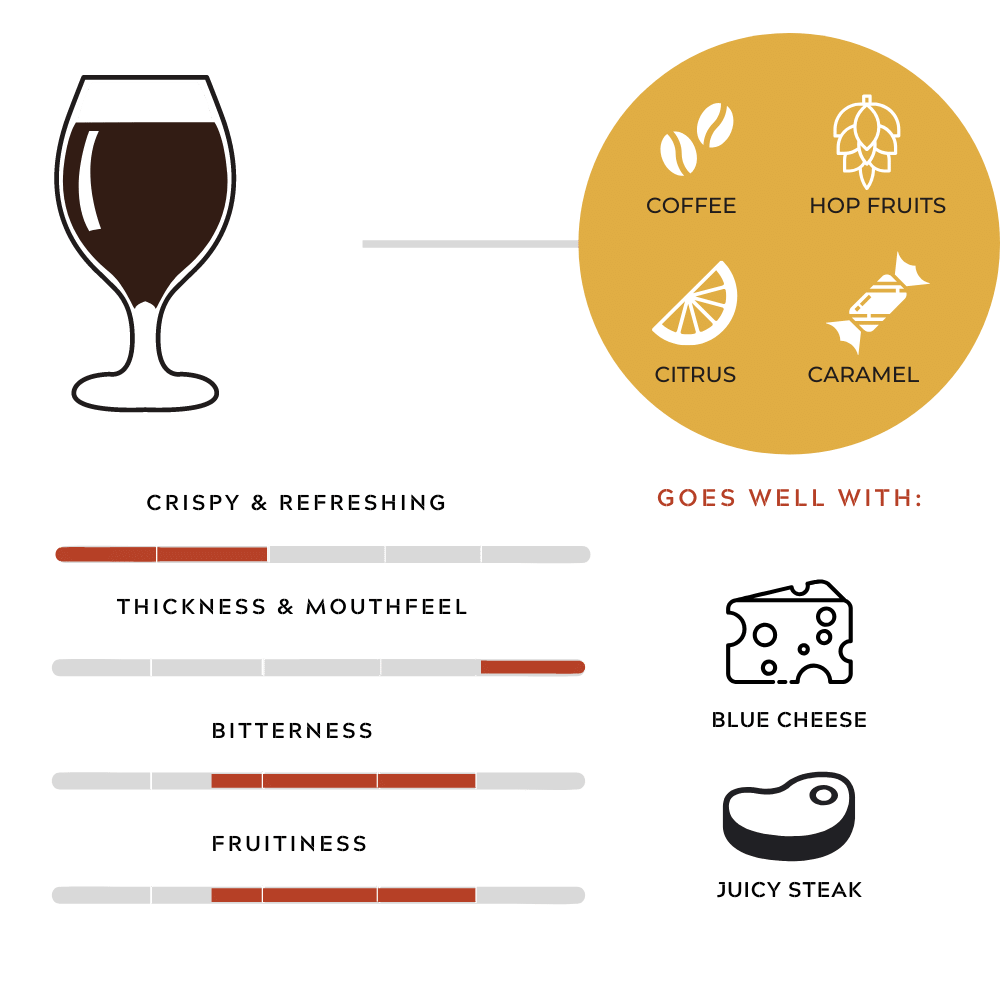Stout ales, commonly referred to as just “stouts”, represent some of the heaviest, darkest, and richly flavoured styles of beer available.
Whilst many will be familiar with the stout category thanks to the famous Guinness brewery in Ireland, there are many brands and breweries to explore when considering this category, all of whom produce a wide variety of sub-styles that are diverse in their specific flavour profiles and general attributes.
That being said, it is possible to characterise these beers as being typically medium to full bodied, light in their overall hop character, moderate to intense in their malt profile and flavour, light in their levels of carbonation, and variable in their alcohol content.
For more on the general flavour profiles of these beers, read this useful article.
Whilst the presence of hoppy fruit flavours is negligible in stouts, they do often contain a moderate amount of hoppy bitterness that is further developed by the use of various heavily roasted malted and unmalted grains that often results in substantially higher levels of bitterness.
When examining the entire stout category, the most important sub-styles to consider include:
An Irish dry stout will, as a general rule, present as a darkly-coloured and medium to full bodied beer that incorporates heavily roasted malted as well as unmalted barley in its malt bill.
The use of heavily roasted unmalted barley plays an important part in the production of these beers as it provides almost no sugar, resulting in beers that are less sweet than other stouts that rely more heavily upon malted grains.
Outside of these characteristics, stouts typically contain low levels of carbonation, with many examples being very creamy in their texture, possessing of imperceptible traces of hoppy fruit flavours, although a moderate degree of hoppy bitterness can prevail, and finally, containing of a very noticeable dry malt profile, with intense flavours of bitter coffee, chocolate, and toasted bread.
Due to its dry and roasted flavours, Irish dry stouts can match incredibly well with many types of rich chocolate desserts, such as souffle, heavy meat dishes, including shepherds pie or meatloaf, and for a far more interesting experience, alongside fresh oysters.
Sweet stouts, also sometimes called milk stouts, are growing in popularity due to their smooth and silky sweet flavour profile that is often influenced by the inclusion of lactose during the brewing process, which is a type of sugar that is commonly found in milk.
Whilst mostly examples of sweet beers that are medium to full bodied in their character, the various examples of this sub-style that do exist are famous for running the gamut in terms of their specific degrees of sweetness as some can taste only slightly sweeter than an Irish dry stout or be as sweet as chocolate milk.
Irrespective of this, sweet and milk stouts typically possess a strong malt profile that is balanced by a light to medium amount of hoppy bitterness.
When looking to consume these beers, expect flavours of sweet chocolate, dark coffee, burnt sugar, and vanilla, making them best consumed on their own or alongside hearty servings of hotly spiced or barbecued glazed meats.
Oatmeal stouts, as the name suggests, include oats as part of their malt bill, which serves to increase the body of the beer and develop a creamier texture without imparting any large amounts of added sweetness.
Because of this, these beers sit somewhere between an Irish dry stout and a sweet or milk stout in terms of their levels of sweetness, making them perfect for those who want a stout with a typically more balanced character.
As a general guide, oatmeal stouts will mostly present as medium to heavy bodied beers that have imperceptible traces of hoppy fruit flavours and moderate amounts of hoppy bitterness that is balanced by a strong malt profile that imparts pronounced flavours of chocolate, caramel, and coffee.
When looking to pair food with this oatmeal stouts, it is often best to match them with a serving of fresh oysters, sweetly glazed red meats, and finally, rich chocolate desserts, such as chocolate truffles.
Oyster stouts are often made in very small batches that usually sell out quickly, making them very hard to come by, highly sought after, and rather expensive.
As is suggested by the name, oysters are one of the primary ingredients used in the production of these beers, which results in stouts that balance the more traditional creamy sweetness of the broader stout category against the salty freshness of oysters.
When looking into this sub-style, most examples found will be medium to full bodied in their nature and strong in their malt profile, which is contrasted not only by a moderate amount of hoppy bitterness but also the salinity of the oysters.
These beers are also commonly classified as a sweet stout as they are almost always a bit on the sweeter side making them excellent alongside a serving of fresh oysters, fish and chips, or creamy fish chowder.
By far the stand out feature of any example of tropical stout that you will find is the strong presence of fruity aromas and flavours, which is contrasted against a considerable malt profile that is dark and roasty yet smooth and sweet rather than dry.
With these beers typically being medium to full bodied in their nature, the common flavours found include the more traditional chocolate, coffee, and caramel found in many other stouts alongside fruit flavours similar to those found in many dark rums.
In addition to this, tropical stouts often contain only low levels of hoppy bitterness and medium to high amounts of carbonation, which, when combined with the attributes mentioned previously, results in beers that pair sublimely well with hotly spiced meat dishes, creamy cheeses, and sweet and fruity desserts.
American brewers are famously fond of imparting their own unique characteristics onto many popular styles of beer traditionally produced in the historical home of beer, Europe.
The American stout sub-style is a perfect example of this as these beers will often blend the traditional medium to full bodied nature and heavy malt profile found in many European stouts with the inclusion of a moderate to high dose of American hops somewhere along the brewing process.
As a general guide, these beers typically contain low to moderately sweet flavours of chocolate, caramel, and roasted coffee along with hoppy fruit flavours of citrus and pine resin.
The hoppy bitterness is moderate to high in these beers, making them perfect when matched with grilled lamb dishes, coffee cake, and light to moderately hotly spiced cuts of meat.
Imperial stouts are famous for representing by far the most flavoursome and richly characterised sub-style of stouts as a whole, with typical examples of these beers being the darkest, thickest, and strongest of flavoured.
Though its roots may lie in Europe, American brewers are particularly fond of producing and experimenting with this sub-style as they often add hefty doses of their native hops to create exquisitely flavoured and thickly textured beers that balance a very pronounced sweet malt profile, with flavours of dark chocolate and strong coffee, against a moderate hop profile of moderate to high hoppy bitterness and flavours of citrus fruits, raisins, and currants.
For a general guide, these beers will always possess a full-body, high alcohol content at around 8% ABV or more, moderate to high amount of both hoppy bitterness and hoppy fruit flavours, and finally, intensely sweet malt profile.
Because of the sub-styles intensely flavoursome nature, they’re often considered a meal in of themselves but they can be enjoyed alongside a serving of strong blue cheese or cut of thick juicy grilled steak.
There's a stout ale out there for everyone. Here are some of the brands and bottles that we recommend you look out for the next time you're browsing online or in-store.
If you’ve been following beer trends recently you would know that Hazy IPAs are all the new craze. Here, we explore what they are & how they taste & pair with food.
Interested in exploring craft beer but not sure where to begin? In this guide, we examine some of the best styles to start with for those looking for some quick guidance.
Beer cocktails? Far from being a far-flung notion, using beer to create exquisite cocktails is strongly advocated for by bartenders the world over. Here, we explore some of the best.







